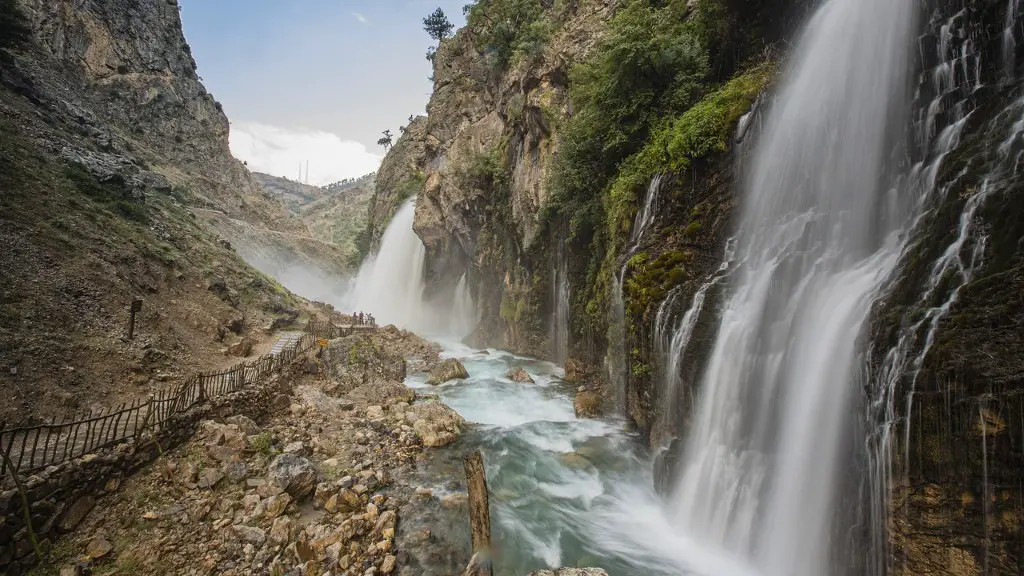The Nile River has been a symbol of strength and life for Egyptians for over five millennia. Its resources flourished the region and established wealth and stability. It was not only a source of goods and services, but also a moving vessel for transportation and communication. It’s often referred to as the lifeblood of the nation. Without it, the Egyptian civilization would not have flourished and grown as it did over the course of thousands of years.
The Nile played an essential role in the success of Ancient Egypt. Its floods provided a replenished supply of silt and soil, allowing farmers to produce higher crop yields. With the assurance of healthy harvests and ample supply of goods, the Ancient Egyptians lived comfortably, allowing them to focus attentions elsewhere. It allowed them to feed a growing population and develop an economy that sustained resources. During times of drought and famine, the Nile’s resources kept the citizens of Egypt alive.
The Nile had a strong impact on the politics and cultures of the region as well. During the New Kingdom period when Ancient Egypt was at its most prosperous, foreign traders flocked to the Nilebanks to trade goods and services. As a result, the Ancient Egyptians were exposed to different cultural and political influences from around the region. This created a unique blend of cultures, politics, and religions that would form the identity of the nation for hundreds of years.
The Nile was also a powerful form of communication. Its waterways connected key cities to major trading centers, allowing Ancient Egyptians to communicate rapidly and efficiently. This enabled the Egyptians to form strong and lasting relationships with distant regions and to share resources and services. These communications enabled the Ancient Egyptians to develop a unified culture that was diverse in its own right.
The Ancient Egyptians also used the Nile River to transport goods and resources. By doing so, they were able to move valuable resources, such as food and building materials, quickly and efficiently from one location to the other. This helped them to develop a strong and unified transportation network that connected major cities, trading centers, and even distant villages. This network provided a greatly needed resource that helped to sustain the Ancient Egyptians for hundreds of years.
Overall, the Nile River has played an essential role in the development and success of the Ancient Egyptian civilization. Its resources provided food and sustenance, its waterways connected different parts of the region, and its political and cultural influences impacted the formation of a thriving nation. Without the Nile, the Egyptians would have had a much harder time fostering their civilization.
The Source of the Nile
The source of the Nile has been the source of much speculation over the years. Many theories have been put forward to explain its origin. It was believed at one time that the river began near Aswan, but it is now known that the source of the Nile is actually in the mountains of East Africa. The White Nile, the longer tributary of the Nile, originates in Ethiopia. The Blue Nile, the shorter tributary, starts in the lakes of the Central African Plateau. The two tributaries meet in Khartoum, Sudan and combine to form the single river known as the Nile.
The White and Blue Niles are two distinct rivers that flow from two very different regions as mentioned before. The White Nile is a slow-moving, muddy river that is fed by a number of tributaries, most importantly the Victoria Nile and the Albert Nile. It is characterized by seasonal floods that deposit rich layers of silt along its banks, making it an ideal habitat for ancient communities. The Blue Nile is a swift, clean river that originates in the highlands of Ethiopia, where it is fed by several high-velocity streams. The Blue Nile is responsible for most of the annual flooding that the Nile is famous for.
The source of the Nile has been an important factor in understanding its contribution to the Egyptian civilization. As mentioned before, the flood waters of the Nile brought essential nutrients and minerals to the soil that made agricultural yields possible. Moreover, the river served as an important channel of transportation and communication that gave the Ancient Egyptians an advantage over the other societies of the region.
The Ancient Egyptians and the Nile
The Ancient Egyptians first settled on the banks of the Nile River around 6000 BC. Over the millennia, they developed a unique relationship with the river and its resources. This relationship enabled them to build a thriving civilization and sustain its inhabitants for centuries. The Nile was both a provider and a protector, supplying them with vital resources and protecting them against outsiders.
The Ancient Egyptians were well-acquainted with the annual flooding of the Nile River and its regular seasonal variations. They used this phenomenon to their advantage, predicting the floods and harvesting the excess water and nutrients to their benefit. The Egyptians also built sophisticated irrigation systems that enabled them to irrigate their crops and made agriculture possible year-round. The Nile also enabled them to build ships and navigate their way along the length of the river connecting distant regions to trade goods and services.
The Ancient Egyptians also recognized the importance of the Nile in providing protection against foreign invaders. They built sprawling fortifications along its banks to keep them safe. Thus, it became a shield and source of military strength, allowing them to repel invaders and protect their kingdom. The Ancient Egyptians also used the river to transport their armies from region to region, enabling them to expand their civilization and extend their influence.
The Symbolism of the Nile
The Ancient Egyptians held the Nile River in great reverence, attributing to it divine status. For example, the goddess Ha was commonly represented as a mongoose that protected the Nile from danger. This can be seen in many of the ancient artworks depicting the Nile and its symbolic animals. Moreover, the Nile was also associated with nourishment, as it was believed to provide sustenance to the people and their crops.
The Ancient Egyptians also believed that the Nile was vital to their destiny, as it enabled them to thrive and become a powerful nation. For them, the river was far more than just a physical force, it represented hope and optimism in the face of adversity. This symbiotic relationship between the people and the river further strengthened the Ancient Egyptians’ sense of identity and unity.
The Ancient Egyptians’ reverence for the Nile was reflected in the many myths and stories that were passed down from generation to generation. These stories often featured creatures such as the
Nile crocodile, representing the unbridled power of the river, and gods and goddesses that ruled over it, such as Hapi and Sobek. In addition, many of the gods and goddesses were closely related to the Nile, such as Isis who was often depicted with a halo of water around her head.
The Legacy of the Nile
Even today, after 5,000 years of use, the Nile River continues to be an integral part of Egyptian culture and society. It is still used for transportation and communication and its resources are still used for irrigation and fishing. Moreover, it is also an important source of electricity, with large hydroelectric dams providing much of the nation’s power. The Nile has become a symbol of pride for the people of Egypt and its presence is sure to continue for many centuries to come.
The importance of the Nile River in the history of the Ancient Egyptians cannot be overstated. Its resources provided much of the material and sustenance needed for their civilization to flourish. Its waters transported goods and resources to different parts of the region, connecting distant cities and villages. Its symbolic presence was a source of inspiration to the people and its impact was felt in practically every aspect of Ancient Egyptian life.
The Ancient Egyptians recognized the vital role that the Nile played in their development, and they reverently paid homage to its importance throughout their history. Today, the legacies of the Nile are seen in the monuments that have been erected in its honor. It is a source of pride and inspiration to the people of Egypt and its influence can still be felt in the culture and society of the nation today.
The Nile in the Modern Age
The Nile continues to be an important lifeline for the people of Egypt and the region. Its resources are still used for irrigation, fishing, and transportation, and it remains one of the most important sources of electricity and drinking water. Its waters are now used to sustain the rapidly growing population of Egypt and the rest of the region. As the population continues to rise, the importance of the Nile in providing for the region is increasingly being recognized.
In recent years, the northern reaches of the Nile have experienced an unprecedented increase in construction and development. Large cities, such as Cairo and Luxor, have been established along its banks, while new hydroelectric projects have been built to harness its power. These projects will provide much-needed electricity to the region and are seen as a way of enhancing the economic development of the region.
The Nile is also currently being used in a variety of tourism-related activities. Boat tours are becoming more and more popular among visitors, and ancient sites along the riverbanks are being opened to the public. The Nile is also a popular destination for fishermen, who come to take advantage of the plentiful resources. In the future, the Nile is sure to play an even larger role in the economy and society of the region.
Conclusion
The Nile River has played an essential role in the success of the Egyptian civilization for thousands of years. Its resources sustained the population and enabled them to develop a thriving nation. Its political and cultural influences shaped the country’s identity and its waterways connected distant regions, creating a unified culture. Even today, its resources continue to be important for the nation’s economy and society, and its presence is sure to continue for many centuries to come.





